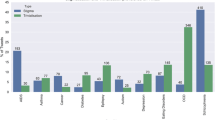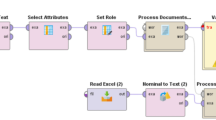Abstract
Twitter, a microblogging service, has become a popular platform for people to express their views and opinions on different issues. A sentiment analysis of the tweets can help in understanding the public opinion on different government decisions. This paper used Twitter data to extract the sentiments of people during the Phase 1 and Phase 2 of the odd–even policy implemented by the Delhi government to curb the air pollution and improve traffic flow. In this study, we used four different lexicon-based approaches: Bing, Afinn, National Research Council emotion lexicon, and Deep Recursive Neural Network-based Natural Language Processing software (CoreNLP) to extract sentiments from tweets and thereby assess overall public opinions. The daily trend obtained for each phase was normalized with the number of tweets and then compared using the Granger causality test. The causality test results showed that the trends obtained during the two phases were significantly different from each other. In particular, public sentiments were found to mostly turn negative during the later stage of the Phase 2 which indicates fading away of the public enthusiasm and positiveness towards the policy during the later stages of the policy implementation.



Similar content being viewed by others
References
Delhi population census data (2011). https://www.census2011.co.in/census/state/delhi.html. Accessed 30 Dec 2017
Hsu A, Zomer A (2017) An interactive air pollution map. https://www.theatlantic.com/health/archive/2014/06/the-air-we-breathe/372411/. Accessed 12 Mar 2017
Wang L, Xu J, Qin P (2014) Will a driving restriction policy reduce car trips? The case study of Beijing, China. Transp Res Part A Policy Pract 67:279–290
Gallego F, Montero J-P, Salas C (2013) The effect of transport policies on car use: evidence from Latin American cities. J Public Econ 107:47–62
Tiwari S, Thomas A, Rao P, Chate DM, Soni VK, Singh S, Ghude SD, Singh D, Hopke PK (2018) Pollution concentrations in Delhi India during winter 2015–16: a case study of an odd-even vehicle strategy. Atmos Pollut Res. https://doi.org/10.1016/j.apr.2018.04.008
Garg N, Sinha AK, Dahiya M, Kumar P (2017) Effect of odd–even vehicular restrictions on ambient noise levels in Delhi city. In: 2017 International conference on advances in mechanical, industrial, automation and management systems (AMIAMS). IEEE, pp 252–256
Zanouda T, Abbar S, Berti-Equille L, Shah K, Baggag A, Chawla S, Srivastava J (2017) On the role of political affiliation in human perception the case of Delhi odd–even experiment. In: Proceedings of the 9th international conference on social informatics, SocInfo 2017. Lecture notes in computer science (including subseries Lecture notes in artificial intelligence and lecture notes in bioinformatics). Springer, pp 74–88. https://doi.org/10.1007/978-3-319-67256-4_8
Chelani AB (2017) Study of local and regional influence on \(PM_{2.5}\) concentration during odd–even rule in Delhi using causal analysis. Aerosol Air Qual Res 17(5):1190–1203
Kumar P, Gulia S, Harrison RM, Khare M (2017) The influence of odd–even car trial on fine and coarse particles in Delhi. Environ Pollut 225:20–30
Mohan D, Tiwari G, Goel R, Lahkar P (2017) Evaluation of odd–even day traffic restriction experiments in Delhi, India. Transp Res Record J Transp Res Board 2627:9–16
Zimmer M, Proferes NJ (2014) A topology of Twitter research: disciplines, methods, and ethics. Aslib J Inf Manag 66(3):250–261
Tumasjan A, Sprenger TO, Sandner PG, Welpe IM (2010) Predicting elections with Twitter: What 140 characters reveal about political sentiment. In: Fourth international AAAI conference on weblogs and social media
Burnap P, Rana OF, Avis N, Williams M, Housley W, Edwards A, Morgan J, Sloan L (2015) Detecting tension in online communities with computational Twitter analysis. Technol Forecast Soc Change 95:96–108
Jansen BJ, Zhang M, Sobel K, Chowdury A (2009) Twitter power: Tweets as electronic word of mouth. J Assoc Inf Sci Technol 60(11):2169–2188
Bakshi H (2011) Framework for crawling and local event detection using twitter data. Rutgers The State University of New Jersey–New Brunswick. https://doi.org/10.7282/T3R78DKZ
Bruns A, Burgess JE, Crawford K, Shaw F (2012) #qldfloods and @QPSMedia: crisis communication on Twitter in the 2011 south east Queensland floods. https://eprints.qut.edu.au/48241/. Accessed 25 July 2018
Kumar A, Jiang M, Fang Y (2014) Where not to go? Detecting road hazards using Twitter. In: Proceedings of the 37th international ACM SIGIR conference on Research & development in information retrieval. ACM, pp 1223–1226. https://doi.org/10.1145/2600428.2609550
Lampos V, Cristianini N (2010) Tracking the flu pandemic by monitoring the social web. In: 2010 2nd international workshop on cognitive information processing (CIP). IEEE, pp 411–416
Collins C, Hasan S, Ukkusuri SV (2013) A novel transit rider satisfaction metric: rider sentiments measured from online social media data. J Public Transp 16(2):2
Luong TTB, Houston D (2015) Public opinions of light rail service in Los Angeles, an analysis using Twitter data. In: iConference 2015 proceedings
Sasaki K, Nagano S, Ueno K, Cho K (2012) Feasibility study on detection of transportation information exploiting Twitter as a sensor. In: Sixth international AAAI conference on weblogs and social media
Sharma SK, Hoque X, Chandra P (2016) Sentiment predictions using deep belief networks model for odd–even policy in Delhi. Int J Synth Emot (IJSE) 7(2):1–22
GNIP full archive search API. http://support.gnip.com/apis/search_full_archive_api/. Accessed 30 Dec 2017
Twitter streaming API. https://developer.twitter.com/en/docs/tutorials/consuming-streaming-data.html. Accessed 12 Dec 2017
Win SSM, Aung TN (2017) Target oriented tweets monitoring system during natural disasters. In: 2017 IEEE/ACIS 16th international conference on computer and information science (ICIS). IEEE, pp 143–148
Liu B, Zhang L (2012) A survey of opinion mining and sentiment analysis. In: Mining text data. Springer, pp 415–463
Snowball. http://snowball.tartarus.org/. Accessed 30 Dec 2017
Sadegh M, Ibrahim R, Othman ZA (2012) Opinion mining and sentiment analysis: a survey. Int J Comput Technol 2(3):171–178
Khuc VN, Shivade C, Ramnath R, Ramanathan J (2012) Towards building large-scale distributed systems for Twitter sentiment analysis. In: Proceedings of the 27th annual ACM symposium on applied computing. ACM, pp 459–464
Speriosu M, Sudan N, Upadhyay S, Baldridge J (2011) Twitter polarity classification with label propagation over lexical links and the follower graph. In: Proceedings of the first workshop on unsupervised learning in NLP. Association for Computational Linguistics, pp 53–63
Nielsen FÅ (2011) A new ANEW: evaluation of a word list for sentiment analysis in microblogs. arXiv preprint arXiv:1103.2903
Mohammad SM, Turney PD (2013) Crowdsourcing a word–emotion association lexicon. Comput Intell 29(3):436–465
Hu M, Liu B (2004) Mining and summarizing customer reviews. In: Proceedings of the tenth ACM SIGKDD international conference on Knowledge discovery and data mining. ACM, pp 168–177
Manning C, Surdeanu M, Bauer J, Finkel J, Bethard S, McClosky D (2014) The Stanford CoreNLP natural language processing toolkit. In: Proceedings of 52nd annual meeting of the association for computational linguistics: system demonstrations, pp 55–60
Bravo-Marquez F, Mendoza M, Poblete B (2013) Combining strengths, emotions and polarities for boosting Twitter sentiment analysis. In: Proceedings of the second international workshop on issues of sentiment discovery and opinion mining. ACM, p 2
Granger CWJ (1969) Investigating causal relations by econometric models and cross-spectral methods. Econ J Econ Soc 37(3):424–438
Acknowledgements
The authors acknowledge the opportunity provided by the 4th Conference of the Transportation Research Group of India (4th CTRG) held at IIT Bombay, Mumbai, India between 17th December, 2017 and 20th December, 2017 to present the work that forms the basis of this manuscript. The authors also gratefully acknowledge the help provided by Aditya Raj and Abhinav Prakash in downloading Twitter dataset used in this study.
Author information
Authors and Affiliations
Corresponding author
Additional information
Publisher's Note
Springer Nature remains neutral with regard to jurisdictional claims in published maps and institutional affiliations.
Rights and permissions
About this article
Cite this article
Chakraborty, P., Sharma, A. Public Opinion Analysis of the Transportation Policy Using Social Media Data: A Case Study on the Delhi Odd–Even Policy. Transp. in Dev. Econ. 5, 5 (2019). https://doi.org/10.1007/s40890-019-0074-8
Received:
Accepted:
Published:
DOI: https://doi.org/10.1007/s40890-019-0074-8




